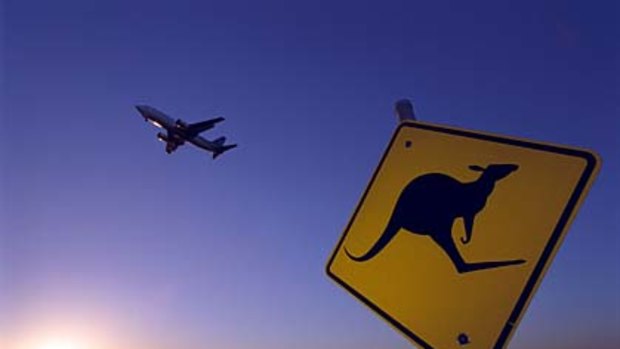
Leaving on a jet plane ... more Australians are choosing overseas holidays.Credit: James Davies
Tourism in Australia is flagging but the industry has grand plans for a revival, writes Clive Dorman.
Australian tourism has hit rock-bottom. Like an addict looking for a road to recovery, the industry finally conceded last week there is a problem.
The State of the Industry report by the federal government's Tourism Research Australia agency, which was presented at the industry's first Tourism Directions conference in Canberra on November 15, laid out the stark reality that tourism ran into a brick wall a decade ago.
That was roughly when Australia ceased to be the world's "flavour of the month", even though consumers around the globe still rate Australia among the top few places they would like to see.
In the past 10 years, however, the industry's performance has been poor: tourism as a percentage of total exports has fallen from about 13 per cent to 8 per cent; tourism has the second-slowest growth of any industry in Australia; the number of Australian tourists travelling overseas has increased by 80 per cent, and the number of domestic visitor nights has decreased by 10 per cent.
"We've been trading off our brand," says Evan Hall, the policy director of Australia's industry lobby group, the Tourism Task Force. "We've lost our international competitiveness."
The industry's cure for its ills is a new "strategic approach" aimed at doubling overnight expenditure on Australia's tourism industry, from $70 billion to $140 billion by 2020. The plan was outlined by Tourism Australia's managing director, Andrew McEvoy, at the Tourism Directions conference.
"Through a shared common goal for Australian tourism, we aim to grow overnight expenditure to as much as $140 billion by 2020 and with domestic day trips included to as much as $160 billion," McEvoy says.
However, to achieve that goal, Australian tourism will need a massive turnaround from virtually zero growth, low investment and low returns, according to the Tourism Research Australia's report.
It will require about 50,000 extra hotel rooms and annual growth of about 7.5 per cent in overnight expenditure for the next decade.
"We need unique and authentic experiences if we are going to reach these new targets," the managing director of the Tourism Task Force, Christopher Brown, says. "While they are ambitious, they are certainly achievable with the right mix of public and private investment. The private sector is committed to providing the additional 50,000 hotel rooms that will be needed along with significantly expanded aviation capacity." However, the grand plan does not directly address the concerns of domestic travellers, who contribute about three-quarters of the industry's $93 billion annual revenue.
In online forums during the past year, many Australians have expressed dissatisfaction with what they regard as high prices, poor value for money and poor customer service in Australia.
Hall concedes the industry's vision is ambitious and will have to address, among other things, the additional staff training required to rectify customer service issues. He says the market is crying out for much more of the "luxury lodge" style of accommodation that will attract more global tourism revenue.
Sign up for the Traveller Deals newsletter
Get exclusive travel deals delivered straight to your inbox. Sign up now.